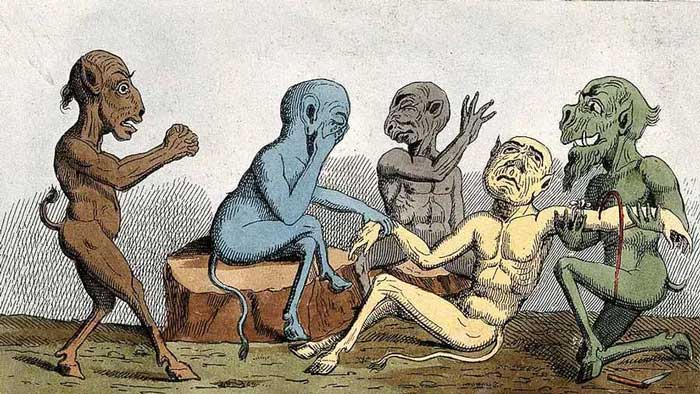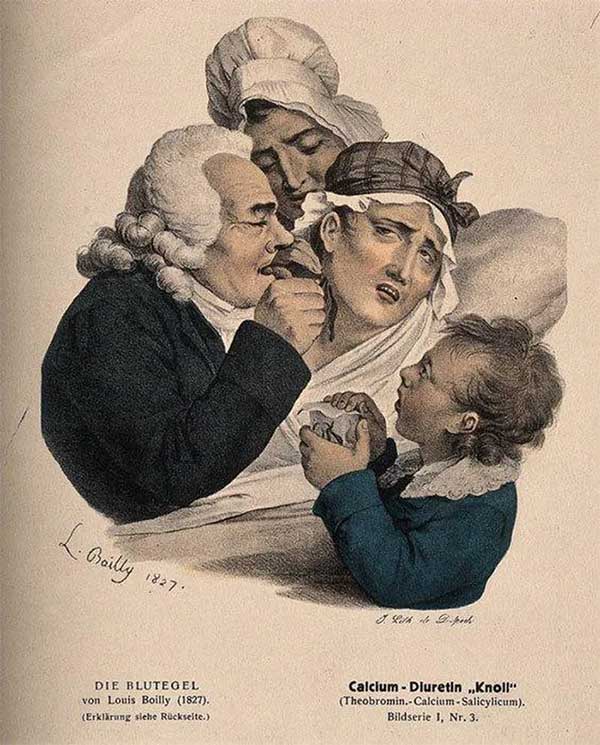The Bloodletting Method for Healing has been around for a long time, and throughout history, this gruesome and often chaotic practice has been favored by physicians worldwide, from the islands of Fiji to Western Europe. However, over time, from ancient to modern times, it has become increasingly difficult to distinguish whether those subjected to this method were ultimately patients or victims.

Bloodletting as a treatment method. (Image: Ancient Origins)
There are many methods for bloodletting. Among them, venipuncture is the most common procedure where doctors use tools like lancets (with various blade sizes) to cut the brachial vein at the elbow to draw blood.
More primitive methods include incision. This procedure requires the doctor to cut and scar the skin with acid to create permanent scars, and also involves cupping to extract blood from a small incision using a suction device. Additionally, in many cases, leeches are often used, as each can suck between 5 to 10 ml of blood, approximately 10 times their body weight. However, as history shows, these techniques often proved more lethal than lifesaving.

13th-century bloodletting scene in Iran. (Image: Ancient Origins)
The Early History of Bloodletting
The Egyptians are believed to be the first practitioners of this method. By 500 BC, it was also established in ancient Greece, as the father of medicine, Hippocrates, recommended bloodletting as a treatment method, particularly at the elbow and knee.
In 400 BC, his successor, Herodotus, continued to propose bloodletting for various ailments, such as restoring appetite, healing, and improving sleep quality. By 100 BC, the Roman medical author Celsus strongly supported cupping and recommended the therapy of making shallow incisions on the skin in certain areas of the body to draw blood.
It is known that in the 3rd century BC, the Greek anatomist Eristratus (who treated the kings of Syria) was the first to hypothesize that diseases arose from an excess of blood in the body. This idea was later developed by a disciple of Hippocrates, Galen, in the 2nd century AD. Galen believed that a cut behind the ear could alleviate headaches and dizziness, while a similar incision on the temple could help cure eye diseases.
Famous Bloodletting Cases

A doctor using leeches to draw blood from a patient. (Image: Ancient Origins).
Despite its widespread popularity for many millennia, there are indeed many notorious cases of bloodletting leading to death. Among them, the French ruler Napoleon was one of the few survivors of venipuncture. This experience left Napoleon deeply traumatized, to the point where he declared that “medicine is the science of murderers.” Other notable survivors include the Queen of France, Marie Antoinette. In 1778, she underwent bloodletting to assist in the birth of her first daughter.
Another was King George IV of England, who lost up to 4436 ml of blood after a procedure in 1820 but miraculously survived for the next 10 years. Compared to most other cases, Napoleon, Marie Antoinette, and George IV were extremely lucky, as bloodletting often led to numerous accidents and fatalities.
One of the earliest famous deaths occurred in 1492 when Pope Innocent VIII and three boys who had transfused blood to him all died from blood loss. In England, Charles II was treated with venipuncture after a stroke in 1685 and died after losing up to 709 ml of blood. Charles’s granddaughter, Queen Anne, later faced a similarly horrific fate. Even the legendary composer Mozart could not escape death; he passed away in 1791 in Vienna after undergoing bloodletting to treat kidney disease.


















































